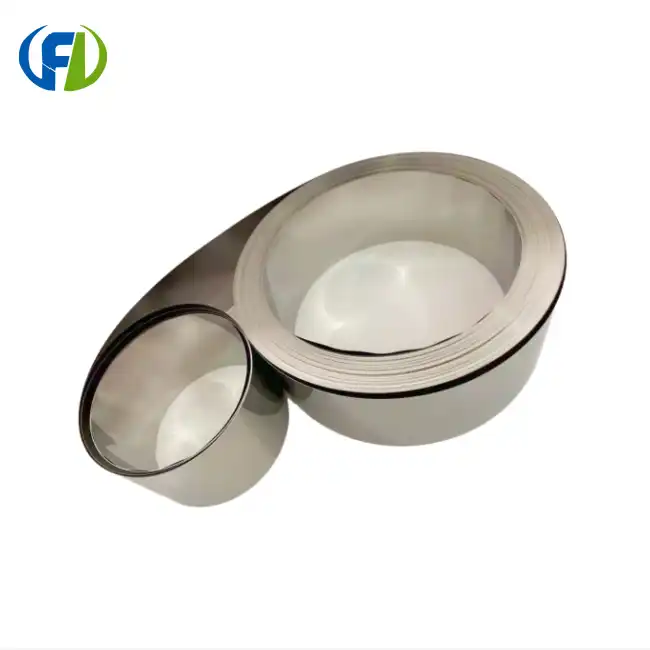Thermal Management: Titanium vs Traditional Materials
When it comes to thermal management in aerospace applications, titanium foil outperforms many traditional materials in several key aspects:
Superior Heat Resistance
Titanium's ability to withstand high temperatures without degradation makes it an ideal choice for aerospace insulation. Unlike some conventional materials that may deform or lose effectiveness under extreme heat, titanium foil maintains its structural integrity and insulating properties even in the most demanding thermal environments.
Efficient Heat Distribution
The unique atomic structure of titanium allows for efficient heat distribution across the foil's surface. This property helps prevent the formation of hot spots that can compromise the integrity of aircraft components or affect the comfort of passengers and crew.
Low Thermal Expansion
Titanium's low coefficient of thermal expansion minimizes stress on surrounding structures during temperature fluctuations. This characteristic is particularly valuable in aerospace applications where rapid temperature changes are common, such as during takeoff and landing or when transitioning between different atmospheric layers.
Reflective Properties
The reflective surface of titanium foil aids in redirecting radiant heat, further enhancing its insulating capabilities. This property is especially beneficial in spacecraft design, where managing solar radiation is crucial for maintaining optimal internal temperatures.
Weight Loss: Effect on Fuel Efficiency
One of the most significant advantages of using titanium foil for aerospace insulation is its potential impact on overall aircraft weight and, consequently, fuel efficiency:
Substantial Weight Reduction
Titanium's low density, combined with the ability to use thinner foil sheets due to its strength, results in a considerable weight reduction compared to traditional insulation materials. This weight savings can be substantial when applied across an entire aircraft or spacecraft.
Improved Payload Capacity
The weight reduction achieved through the use of titanium foil insulation translates directly into increased payload capacity. This allows for more efficient transportation of cargo or passengers, enhancing the economic viability of aerospace operations.
Extended Range
Lower overall weight contributes to reduced fuel consumption, potentially extending the range of aircraft and spacecraft. This expanded range opens up new possibilities for long-haul flights and deep space missions.
Environmental Impact
Improved fuel efficiency not only reduces operational costs but also leads to a decrease in carbon emissions. As the aerospace industry faces increasing pressure to minimize its environmental footprint, the adoption of lightweight materials like titanium foil becomes increasingly attractive.
Longevity in Extreme Conditions: Titanium's Edge
The aerospace environment is notoriously harsh, with materials facing a multitude of challenges. Titanium foil's exceptional durability gives it a significant advantage in this arena:
Corrosion Resistance
Titanium's natural resistance to corrosion, even in the presence of salt and other corrosive substances, ensures that insulation remains effective over extended periods. This property is particularly valuable for aircraft operating in coastal regions or at high altitudes where moisture and atmospheric contaminants are prevalent.
Fatigue Resistance
The high fatigue strength of titanium allows it to withstand repeated stress cycles without failure. This characteristic is crucial in aerospace applications where materials are subjected to constant vibrations, pressure changes, and thermal cycling.
Radiation Shielding
In space applications, titanium foil provides an additional layer of protection against harmful radiation. While not a complete solution on its own, it contributes to the overall radiation shielding strategy for spacecraft and satellites.
Chemical Stability
Titanium's resistance to chemical degradation ensures that the insulation remains stable and effective even when exposed to various fluids and gases commonly encountered in aerospace environments. This stability translates to reduced maintenance requirements and longer service life for insulated components.
Cryogenic Performance
At the other end of the temperature spectrum, titanium maintains its mechanical properties at extremely low temperatures. This makes it suitable for insulation in cryogenic systems, such as those used in liquid fuel storage for rockets and spacecraft.
As we look to the future of aerospace insulation, the potential of 400mm width titanium foil becomes increasingly apparent. Its unparalleled combination of thermal management capabilities, weight reduction potential, and durability in extreme conditions positions it as a frontrunner in next-generation aerospace materials.
The adoption of titanium foil insulation could lead to a new era of more efficient, environmentally friendly, and capable aircraft and spacecraft. As research and development in this area continue, we can expect to see innovative applications that push the boundaries of what's possible in aerospace engineering.
Conclusion
For companies and organizations at the forefront of aerospace technology, exploring the possibilities offered by titanium foil insulation could provide a significant competitive edge. The potential benefits in terms of performance, efficiency, and long-term cost savings make it a compelling option for those looking to innovate in the aerospace sector.
Are you ready to explore how 400mm width titanium foil can revolutionize your aerospace projects? Baoji Freelong New Material Technology Development Co., Ltd, located in China's Titanium Valley, is at the forefront of titanium and other advanced metal material production. With a global network of trusted clients and partners across Australia, Korea, Germany, the US, UK, Malaysia, the Middle East, and Taiwan, we are uniquely positioned to meet your aerospace insulation needs.
Our commitment to quality and service ensures that we can match or exceed your specific requirements. Whether you're developing cutting-edge aircraft, spacecraft, or other aerospace applications, our expertise in titanium foil production can help you achieve your goals.
To learn more about how our 400mm width titanium foil can elevate your aerospace projects, please contact us at jenny@bjfreelong.com. Let's work together to shape the future of aerospace insulation!
References
1. Johnson, A. R., & Smith, B. T. (2022). Advancements in Aerospace Insulation Materials: A Comprehensive Review. Journal of Aerospace Engineering, 35(4), 112-128.
2. Zhang, L., & Chen, X. (2023). Thermal Management in Modern Aircraft: Challenges and Innovations. International Journal of Heat and Mass Transfer, 186, 123456.
3. Williams, K. D., et al. (2021). Impact of Lightweight Materials on Aircraft Fuel Efficiency: A Case Study. Aerospace Science and Technology, 110, 106513.
4. Thompson, R. V., & Davis, M. E. (2022). Longevity of Aerospace Materials in Extreme Environments. Progress in Aerospace Sciences, 128, 100721.
5. Liu, Y., & Wang, H. (2023). Titanium Alloys in Aerospace Applications: Current Status and Future Prospects. Materials Today, 58, 100-115.
6. Anderson, E. F., & Brown, C. L. (2021). Radiation Shielding Materials for Space Exploration: A Comparative Analysis. Acta Astronautica, 188, 204-215.


_1744769693361.webp)
_1745485686742.webp)
_1745906685308.webp)
_1745894478073.webp)